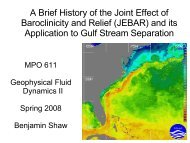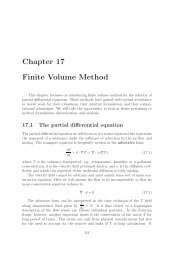2007 (PDF) - Rosenstiel School of Marine and Atmospheric Science ...
2007 (PDF) - Rosenstiel School of Marine and Atmospheric Science ...
2007 (PDF) - Rosenstiel School of Marine and Atmospheric Science ...
Create successful ePaper yourself
Turn your PDF publications into a flip-book with our unique Google optimized e-Paper software.
<strong>Marine</strong> Life<br />
‘Nursing’ Coral Fragments<br />
Until recently, branching elkhorn (Acropora palmata) <strong>and</strong> staghorn<br />
(Acropora cervicornis) corals were among the most abundant reefbuilding<br />
corals in Caribbean <strong>and</strong> Florida reefs. However, in the<br />
last few decades a drastic regional decline <strong>of</strong> this genus has been recorded<br />
due mainly to elevated temperatures, coral diseases, <strong>and</strong> the<br />
impact <strong>of</strong> hurricanes. This region-wide decline, which has resulted<br />
in losses <strong>of</strong> up to 95 percent <strong>of</strong> colonies at several locations, has<br />
prompted the listing <strong>of</strong> these species as “threatened” under the U.S.<br />
Endangered Species Act in 2006.<br />
In response to the need for localized efforts to protect <strong>and</strong> recover<br />
surviving coral populations, Dr. Diego Lirman <strong>and</strong> graduate student<br />
James Herlan established an underwater<br />
nursery dedicated to the propagation <strong>of</strong><br />
the threatened staghorn coral. The underwater<br />
nursery, located in the waters <strong>of</strong> Biscayne<br />
National Park, is part <strong>of</strong> a network <strong>of</strong><br />
Acropora nurseries established with support<br />
from The Nature Conservancy, NOAA, <strong>and</strong><br />
the National Park Service.<br />
Fragment <strong>of</strong> staghorn<br />
coral demonstrating fast regrowth<br />
between July <strong>2007</strong><br />
<strong>and</strong> October <strong>2007</strong>. Photo<br />
credit: James Herlan <strong>and</strong><br />
Diego Lirman<br />
The goals <strong>of</strong> the coral nursery program are<br />
to develop effective coral fragmentation <strong>and</strong><br />
propagation methodologies, <strong>and</strong> to evaluate<br />
the role <strong>of</strong> coral genetics on the resilience <strong>of</strong><br />
corals to disturbance. Coral nurseries provide<br />
a unique opportunity to learn about<br />
coral growth <strong>and</strong> survivorship, as well as<br />
how to stabilize corals damaged by physical<br />
disturbances.<br />
A total <strong>of</strong> 250 staghorn coral fragments<br />
have been collected <strong>and</strong> placed on cement<br />
platforms where they are individually measured<br />
at monthly intervals to assess growth<br />
<strong>and</strong> mortality patterns. The fast growth<br />
rate <strong>of</strong> these species -- up to 15 cm per<br />
year -- makes them ideal c<strong>and</strong>idates for reef restoration programs.<br />
It is expected that the staghorn fragments kept in the University <strong>of</strong><br />
Miami’s nursery will provide an exp<strong>and</strong>ing coral stock to be used<br />
for reef restoration.<br />
Coral Cooldown<br />
Scientists have known that hurricanes reduce sea-surface temperatures<br />
upon passage. In fact, <strong>Rosenstiel</strong> <strong>School</strong> Pr<strong>of</strong>essor Peter<br />
Glynn was the first to put forth the hypothesis that thermally<br />
stressed corals might benefit from cooling due to proximal hurricane<br />
passage. But until<br />
now, all evidence for this<br />
phenomenon has been<br />
anecdotal or qualitative,<br />
or researchers have<br />
chosen to focus solely<br />
on the damaging effects<br />
<strong>of</strong> hurricanes on coral<br />
reef habitats. As seemingly<br />
sensitive animals,<br />
corals may seem unlikely<br />
Pacific staghorn coral (Acropora sp.) Photo<br />
credit: Andrew Baker<br />
c<strong>and</strong>idates to benefit from strong wind <strong>and</strong> wave conditions, but<br />
as <strong>Rosenstiel</strong> <strong>School</strong> graduate student Derek Manzello <strong>and</strong> a team<br />
from the National Oceanic <strong>and</strong> <strong>Atmospheric</strong> Administration<br />
(NOAA) discovered, the intense cooling effect tropical cyclones<br />
<strong>and</strong> storm force winds have on the waters <strong>of</strong> the Atlantic are giving<br />
corals a much-needed boost to encourage repopulation.<br />
Hurricane development is dependent on warm sea surface temperatures<br />
<strong>and</strong> <strong>of</strong>ten closely linked with widespread coral bleaching<br />
events. Corals survive mainly in shallow water where photosynthetic<br />
algae reside symbiotically within the coral’s transparent tissue<br />
using the sun’s energy to convert it into food for the coral. Even the<br />
slightest changes in water temperature can cause widespread bleaching,<br />
forcing the tiny food-producing algae to be expelled from the<br />
coral tissue.<br />
Milne Bay, Papua New Guinea. Photo credit: Michael Schmale<br />
In a study published in the July <strong>2007</strong> issue <strong>of</strong> the Proceedings <strong>of</strong><br />
the National Academy <strong>of</strong> <strong>Science</strong>s, the team, organized by Manzello,<br />
documented the potential benefits <strong>of</strong> hurricane <strong>and</strong> tropical<br />
storm weather on bleached coral reefs. Researchers showed<br />
evidence suggesting that by circulating colder deep ocean waters<br />
toward the surface, high winds surrounding hurricanes <strong>and</strong> tropical<br />
storm events cooled surface waters enough to promote rapid<br />
recovery <strong>of</strong> bleached corals stressed by anomalously warm waters<br />
<strong>of</strong>f the Florida coast. The study focused on the magnitude <strong>and</strong> duration<br />
<strong>of</strong> sea temperature<br />
cooling after the passage<br />
<strong>of</strong> hurricanes <strong>and</strong> tropical<br />
storms near five reef sites<br />
on the Florida Reef Tract<br />
between 1998 <strong>and</strong> 2005.<br />
Data analyzed from the<br />
2005 Atlantic hurricane<br />
season -- the busiest in<br />
recorded history -- showed<br />
that the area affected by<br />
hurricane cooling is much<br />
Cervicornis polyps. Photo credit: Wade<br />
Cooper<br />
larger than the narrow b<strong>and</strong>s where damage actually occurs to<br />
reefs.<br />
A <strong>Marine</strong> “Connection”<br />
A special issue <strong>of</strong> Oceanography published in <strong>2007</strong> features articles<br />
<strong>and</strong> cover images by faculty,<br />
researchers <strong>and</strong> staff members<br />
from the <strong>Rosenstiel</strong> <strong>School</strong>.<br />
The edition focuses on<br />
marine population connectivity,<br />
a concept described in an<br />
article authored by <strong>Rosenstiel</strong><br />
<strong>Marine</strong> Biology <strong>and</strong> Fisheries<br />
Division Chair <strong>and</strong> Maytag<br />
Pr<strong>of</strong>essor <strong>of</strong> Ichthyology, Dr.<br />
Robert Cowen, <strong>and</strong> colleagues<br />
Drs. Glen Gawarkiewicz,<br />
Jesus Pineda <strong>and</strong> Simon<br />
Thorrold from Woods Hole<br />
Oceanographic Institution<br />
(WHOI), <strong>and</strong> Cisco Werner<br />
from UNC-Chapel Hill<br />
(UNC-CH).<br />
Larval transport <strong>and</strong> dispersal play a critical role in marine connectivity,<br />
having important consequences on coastal <strong>and</strong> nearshore<br />
marine populations as highlighted in an article by Drs. Jesus Pineda<br />
(WHOI), Jonathan Hare (NOAA) <strong>and</strong> Su Sponaugle (<strong>Rosenstiel</strong><br />
<strong>School</strong>). Modern modeling <strong>and</strong> computational skills also play a<br />
critical role in studying connectivity. Biological <strong>and</strong> physical models<br />
are needed to uncover the dynamics at work in our oceans, as is<br />
detailed in a piece by Drs. Cowen <strong>and</strong> Claire Paris-Limouzy, also<br />
<strong>of</strong> the <strong>Rosenstiel</strong> <strong>School</strong>, in collaboration with Dr. Cisco Werner<br />
(UNC-CH). The article details current model tracking for connectivity,<br />
as well as the direction that needs to be taken in improving<br />
the representation <strong>of</strong> physical dynamics <strong>and</strong> the development <strong>of</strong><br />
new algorithms. The authors also propose the use <strong>of</strong> more integrated<br />
models that can help to inform how field experiments may<br />
be designed for greater effectiveness.<br />
Dr. Chris Langdon measures the<br />
vertical extension rate <strong>of</strong> a coral<br />
sample. Photo credit: Barbra<br />
Gonzalez<br />
Corals & Climate Change<br />
In August <strong>2007</strong>, Drs. Chris Langdon <strong>and</strong> Andrew Baker <strong>of</strong> the <strong>Marine</strong> Biology <strong>and</strong> Fisheries Division inaugurated<br />
a first-<strong>of</strong>-its-kind laboratory to tackle the global impacts that climate change is having on corals.<br />
The modest lab is the first to maintain corals under precisely controlled temperature <strong>and</strong> carbon dioxide<br />
conditions, while exposing them to natural light conditions.<br />
Using two Caribbean coral species, Montastraea faveolata (mountainous star coral) <strong>and</strong> Porites furcata<br />
(finger coral), the team is studying how increasingly acidic oceans, caused by increasing atmospheric<br />
carbon dioxide, can affect corals when accompanied with increasing temperatures. Corals in the laboratory<br />
are being stressed with differing levels <strong>of</strong> carbon dioxide <strong>and</strong> temperatures, like those they might<br />
experience in the next 50 to 100 years, to see if skeletal development is affected.<br />
Since the year 1800, nearly 30 percent <strong>of</strong> total global carbon dioxide emissions have been absorbed<br />
by the ocean. Despite the immensity <strong>of</strong> the world’s oceans, this accumulation is gradually lowering the<br />
pH <strong>of</strong> ocean water, making it more acidic <strong>and</strong> in turn, making it difficult for corals <strong>and</strong> other<br />
important marine organisms to thrive.<br />
The duo’s experimental studies are simulating scenarios already occurring in the Florida Keys.<br />
The Florida reef tract is the most extensive living coral reef system in the continental United<br />
States. Langdon’s research has shown that a coral’s ability to produce a limestone skeleton<br />
decreases substantially as oceans become more acidic, a conclusion which suggests that these<br />
organisms will grow at a slower rate, or their skeletons will become more fragile (less dense);<br />
a process that can be compared to osteoporosis in humans. As a result, reef structures will<br />
become increasingly brittle <strong>and</strong> unable to develop extensively as erosion <strong>and</strong> other factors will<br />
wear them away faster than they can grow.<br />
The Coral Climate Change Lab was made possible through funding from the National <strong>Science</strong><br />
Foundation, the Packard Foundation, Conservation International <strong>and</strong> the Wildlife Conservation<br />
Society.<br />
Bleached coral. Photo credit:<br />
Andrew Baker<br />
15 16




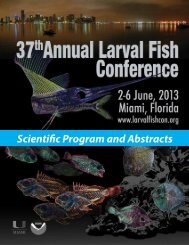
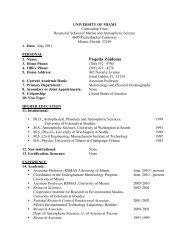
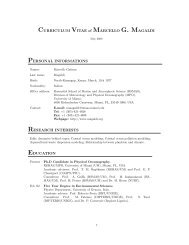
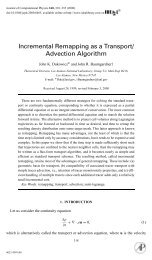


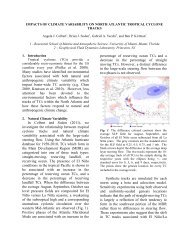

![Wavelength [μm] ZENITH ATMOSPHERIC TRANSMITTANCE](https://img.yumpu.com/26864082/1/190x143/wavelength-i-1-4-m-zenith-atmospheric-transmittance.jpg?quality=85)
